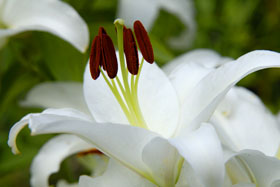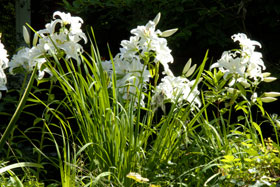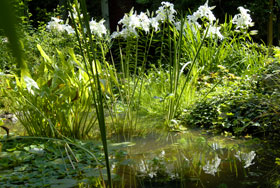Chronicle July 2008 | Chronicle September 2008
"Gardening is the purest of human pleasures." Francis Bacon
August 2008
A summer without lilies isn’t a real summer; one simply can’t live without lilies. My main interest is in oriental lilies.
I want scent, grandeur, and splendour, and I want them in abundance and profusion.
For me, lilies should be planted in pots and in the ground so that their heavy and heavenly scent can permeate the garden.
Lilies are quite important to me. In my eyes, they add more than a touch of the exotic to any garden. The Turk’s cap lilies (lilium martagon) are the first to put in an appearance, followed by an array of different lilies throughout the summer. The lily family is so large, but the orientals are my favourites. They prefer acid soil and mild, moist summers. Over the years, I’ve tried and tested many different lilies and have finally realised that lilies come and go. I’ve got to replenish them each year; they don’t always come back, however much one wishes that they would. So I play it safe and plant quite a few each year.
This year, something very strange happened. For many years I’ve had a white favourite, Casablanca, which is so grand and beautifully scented. It’s been one of the highlights of my garden from the end of August. But from having several hundred in bloom a few years ago, this year we were down to a small handful; sadly and quite simply, they’re on their way out.
Last year I came across a lily called Siberia. Where lilies are concerned, there are down-facing ones and up-facing ones. Casablanca, which was introduced in 1982, is regularly acclaimed as the best white oriental down-facing.
But then along came Siberia. It produces an upright flower with star-shaped, pristine white petals with bright green centers and exudes a heavenly spicy fragrance; I can only say “Hallelujah”!
I got hold of some 20 or so bulbs, planted them by our pond, where they remained and thrived. They proved to be quite remarkable. The most astonishing thing — the great wonder — was that I didn’t need to support them with a cane. No need for support! They stood there, firm and erect, and I could only gasp: how could this happen? The following year, I pulled out all the stops, bought another couple of hundred and planted them around the garden. But then came the disappointment. Elsewhere in the garden I still need to give them support — and unsightly canes are exactly what I want to avoid. But for lily lovers it’s just par for the course and a fact of life: tall lilies often need a cane support. So I just grit my teeth, but was quite disappointed.
But wait a second, what’s happening here? Once again, they shot up by the pond. And not only that — they’d divided themselves in the spring. It’s quite unusual for a bulb to divide itself in a single year. Still just as magnificent: tall, elegant and erect, and without the need for a single cane support by the pond. What’s happening here? Here’s quote from a website about growing lilies (Pacific Northwest Lily Society):
“What is the single most important thing to know about growing lilies? Drainage, drainage, drainage! All lilies must have it - the surest way to kill a lily bulb is to plant it in a low spot in poorly drained, heavy soil. You will not see that lily come up the following year!”
Surely it can’t be true, don’t say to me that this is a lily that needs damp soil. I just stood open mouthed and merely shook my head.
I believe that I’ve found a lily that prefers to stand in damp soil. As the above quotation makes clear, this is unusual, to say the least. Oh how my Siberia lilies thrive and bloom! I can only say: what a lily, it’s tall, it’s stately, it’s white as chalk and it smells wonderful. It’s a lily one MUST have in a garden.
These lilies bloom in August, and since August is always “blessed” with a few torrential downpours now and again, the lilies often become discoloured. That’s not such a pretty sight, so why take a pragmatic approach and remove the seed heads? When the rain cames, there’s no damage to the lily and it remains pristine white. On the other hand, the loveliest thing is if the seed heads are allowed to remain...
In our garden, Siberia begins to flower at the beginning of August and continues for over three weeks. Currently it’s one of my favourite lilies. New varieties will undoubtedly appear, new hybrids are constantly being crossed, but a lily such as Siberia is something one simply must have. So white, so beautiful, so fragile, and what a wonderful fragrance! If you take away the stamens and pistils, the lilies will also last up to a week longer than if leave them.
Though I’ve never been to Siberia, I understand why there’s a lily named after it. White as snow.
Lilies can be planted in the autumn and the spring; there are different theories as to which is best. Personally, I plant mine in February/March. It’s then that I get my bulbs, and what has worked for me is to keep them in a dark, cold storage area at between zero and five degrees centigrade.
I plant them in individual plastic pots, water them and then let them rest undisturbed until the worst frost nights are over; its then time to take these beauties out and plant them in the garden.
But now it’s time to go out to the garden and enjoy my beloved Siberia lilies yet again …


